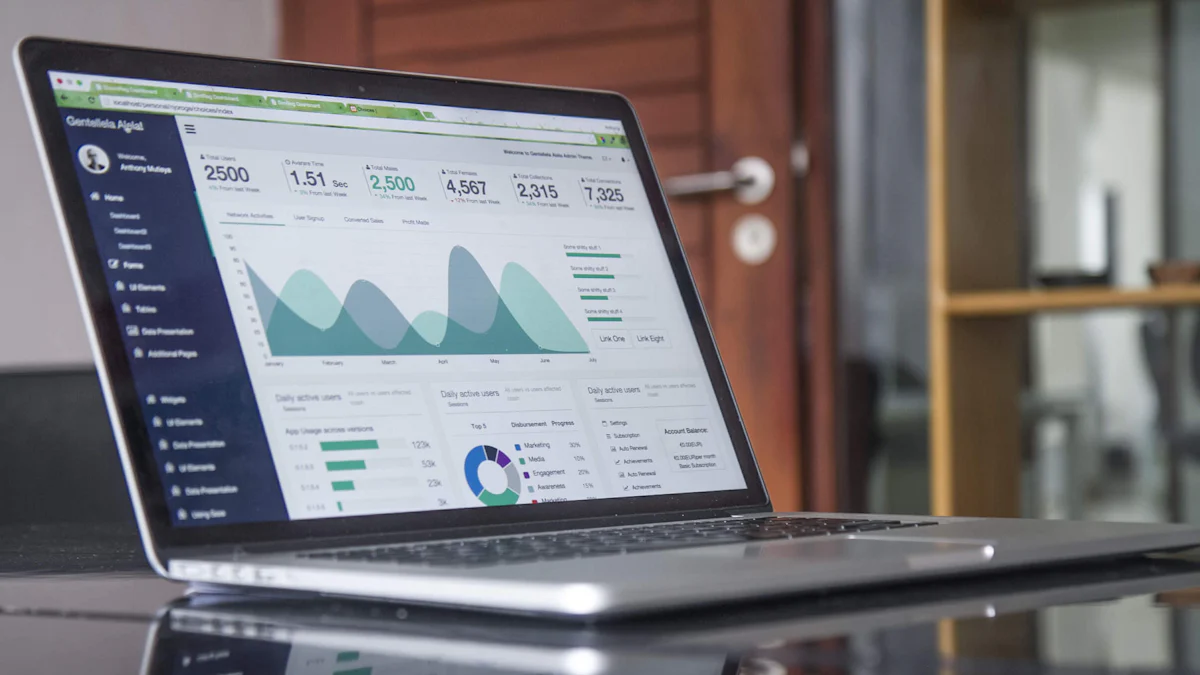5 Steps to Scale Your eCommerce Business with Marketing Automation

Imagine running your eCommerce business without spending hours on repetitive tasks. That’s the magic of marketing automation. It helps you save time, reduce errors, and deliver personalized experiences to your customers. Did you know 72% of successful companies use automation to outperform their competition? Whether it’s automating email campaigns or managing social media, commerce marketing automation can help you scale your e-commerce business faster. By streamlining your operations, you’ll focus on growth and create a seamless customer journey. Ready to take your business to the next level? Let’s dive in!
Assess Your Business Needs for Commerce Marketing Automation
Identify Pain Points in Your eCommerce Operations
Before diving into automation, you need to pinpoint the challenges slowing down your e-commerce business. Are repetitive tasks eating up your time? Is manual bookkeeping causing errors? Maybe your shipping process feels like a bottleneck. These are common pain points that commerce marketing automation can solve.
Here’s how automation can help:
- Save time by automating repetitive tasks like email campaigns or inventory updates.
- Reduce human errors in processes like accounting or order management.
- Send real-time, contextual messages to your customers, improving engagement.
- Maximize your marketing ROI by focusing on high-impact strategies.
- Maintain consistent branding across all channels, from social media to email.
By addressing these issues, you’ll free up resources to focus on growth and delivering better experiences for your customers.
Define Growth Goals for Your E-Commerce Business
What does success look like for your e-commerce business? Setting clear growth goals will guide your automation strategy. Whether you want to improve personalization, streamline inventory management, or boost cross-channel integration, automation can help.
| Growth Goal | How Automation Helps |
|---|---|
| Improved personalization | Enables targeted marketing campaigns based on customer preferences and purchase histories. |
| Better inventory management | Provides real-time updates to prevent stockouts and overstocking, optimizing storage costs. |
| Faster decision-making | Offers quick access to analytics for timely and informed decision-making. |
| Improved cross-channel integration | Ensures consistent brand messaging across various platforms, enhancing visibility. |
| Cost efficiency | Reduces operational costs by automating repetitive tasks and standardizing processes. |
Define your priorities and align them with the right tools to achieve measurable results.
Understand Your Target Audience and Segmentation
Knowing your audience is key to successful ecommerce automation. Start by segmenting your customers into meaningful groups. For example:
- High-value customers who make frequent purchases.
- New customers who need nurturing to build loyalty.
- Lapsed customers who might respond to re-engagement campaigns.
- Budget-conscious customers looking for deals.
You can also segment based on demographics, purchase history, or engagement levels. For instance, track email opens and clicks to identify active leads. Use psychographic data like hobbies or opinions to craft campaigns that resonate. By understanding your audience, you’ll create personalized experiences that keep customers coming back.
Pro Tip: Use automation tools to analyze customer behavior and refine your segments over time. This ensures your campaigns stay relevant and effective.
Choose and Implement the Right Tools for E-Commerce Marketing Automation

Research and Compare Marketing Automation Tools
Finding the right tool for your e-commerce business can feel overwhelming, but it doesn’t have to be. Start by identifying what you need most. Are you looking to improve email campaigns, manage customer data, or track analytics? Once you know your priorities, compare tools based on their features and how they align with your goals.
Here are some top-rated tools for e-commerce businesses in 2023:
- Klaviyo: Perfect for personalized emails and SMS campaigns.
- HubSpot: Great for email marketing and social media management.
- Mailchimp: User-friendly and affordable for small businesses.
- ActiveCampaign: Focuses on creating personalized customer experiences.
- Salesforce Marketing Cloud: Uses AI to manage campaigns across channels.
- Google Analytics: Tracks website visitor activity for free.
- Conversio: Helps with email campaigns and customer relationship management.
When comparing tools, look for these key features:
- Robust email marketing capabilities.
- Customer segmentation for targeted campaigns.
- Omni-channel marketing to reach customers everywhere.
- Analytics and reporting to measure success.
The right tool will simplify your marketing strategy and help you focus on maximizing efficiency.
Focus on Integration and Scalability for E-Commerce Platforms
Your e-commerce platform needs tools that work seamlessly with your existing systems. Integration ensures smooth data sharing and eliminates manual work. Look for tools that offer:
- Customer Data Management: Centralizes customer information for better campaigns.
- Campaign Workflow Builder: Automates marketing tasks with ease.
- Reporting and Analytics: Tracks performance and ROI.
- Scalability: Handles growth as your business expands.
For example, tools like Salesforce Marketing Cloud and ActiveCampaign excel in integration and scalability. They allow you to manage complex campaigns while keeping everything streamlined. This ensures your marketing automation workflows grow with your business.
Train Your Team to Maximize Tool Effectiveness
Even the best tools won’t deliver results if your team doesn’t know how to use them. Proper training is essential. Make sure everyone understands how automation impacts their roles and how to leverage it for better results.
Here’s how to get started:
- Organize training sessions to familiarize your team with the tools.
- Highlight how automation reduces stress by eliminating repetitive tasks. Did you know 65% of workers feel less stressed thanks to automation?
- Encourage collaboration to ensure everyone is aligned on goals.
When your team feels confident, they’ll use the tools effectively to drive engagement and convert leads into loyal customers.
Pro Tip: Regularly update your team on new features and best practices to stay ahead in the game.
Personalize Customer Engagement with Automation
Use Data to Drive Personalized Marketing Campaigns
Personalization is the secret sauce for boosting customer engagement in e-commerce. By using data, you can create marketing campaigns that feel tailor-made for your customers. Think about it—when customers see offers that match their preferences, they’re more likely to buy and stick with your brand. This is where ecommerce automation shines. It helps you analyze customer data and deliver relevant messages at the right time.
For example, you can set up welcome campaigns for new subscribers or send cart abandonment emails to remind customers about unfinished purchases. Post-purchase upsell campaigns are another great way to suggest complementary products. You can even celebrate birthdays with special discounts. These strategies not only drive conversions but also build loyalty by making customers feel valued.
Here’s a quick look at the types of data you can use:
| Type of Data | Description |
|---|---|
| Personal data | Includes names, emails, and other identifiable information. |
| Engagement data | Tracks interactions like email opens and social media likes. |
| Transactional data | Focuses on purchase history and payment preferences. |
| Behavioral data | Analyzes actions like clicks and time spent on your site. |
| Psychographic data | Explores hobbies, interests, and values for deeper insights. |
By leveraging this data, you’ll create campaigns that resonate with your audience and keep them coming back.
Automate Key Customer Retention Strategies
Keeping customers loyal is just as important as attracting new ones. With ecommerce automation, you can implement customer retention strategies that run on autopilot. For instance, loyalty programs reward repeat purchases with points or discounts. Subscription models offer ongoing value, while post-purchase engagement keeps your brand top of mind.
Here are some strategies you can automate:
- Send personalized onboarding emails to welcome new customers.
- Trigger cart abandonment reminders to recover lost sales.
- Offer exclusive discounts to incentivize repeat purchases.
Automation also makes it easy to re-engage lapsed customers. Win-back campaigns with special promotions can bring them back into your funnel. By automating these tasks, you’ll save time while maximizing efficiency and improving customer retention.
Build Loyalty Through Tailored Experiences
Loyalty isn’t just about discounts—it’s about making customers feel special. Tailored experiences do exactly that. With ecommerce automation, you can customize the shopping journey based on individual preferences. For example, you can recommend products based on past purchases or create personalized storefronts for each user.
Customers also love recognition. Birthday offers, abandoned cart reminders, and rewards for frequent purchases show that you value their business. These small touches foster a sense of belonging and strengthen your relationship with them. When customers feel appreciated, they’re more likely to stay loyal and even advocate for your brand.
Remember, loyalty is built over time. By consistently delivering personalized experiences, you’ll turn one-time buyers into lifelong fans.
Optimize Marketing Campaigns with Data Insights

Track and Analyze Key Metrics in E-Commerce Campaigns
Tracking the right metrics is essential for improving your e-commerce campaigns. These numbers tell you what’s working and what needs fixing. By focusing on key performance indicators (KPIs), you’ll make smarter decisions and get better results.
Here’s a quick breakdown of the most important metrics to monitor:
| Metric | Importance |
|---|---|
| Traffic Sources | Shows which channels bring the most visitors, helping you refine your marketing strategy. |
| Bounce Rate | Measures user engagement; a high rate means your site needs optimization. |
| Conversion Rate | Tracks how well you’re turning visitors into customers. |
| Average Order Value (AOV) | Helps you increase revenue by understanding spending patterns. |
| Customer Acquisition Cost (CAC) | Reveals how cost-effective your campaigns are. |
| Customer Lifetime Value (CLV) | Predicts long-term profitability, guiding retention efforts. |
| ROI (Return on Investment) | Tells you if your campaigns are profitable and worth scaling. |
By keeping an eye on these metrics, you’ll uncover opportunities to improve your marketing strategy and enhance the customer experience.
Use A/B Testing to Refine Marketing Strategies
A/B testing is a powerful way to optimize your campaigns. It lets you compare two versions of a campaign to see which one performs better. For example, you could test two subject lines for your emails or try different layouts for your landing pages.
Follow these best practices for effective A/B testing:
- Pick a clear goal, like increasing conversions or reducing abandoned carts.
- Develop a hypothesis. For instance, “A shorter subject line will lead to higher email open rates.”
- Change one element at a time, such as the call-to-action (CTA) or image placement.
- Set a proper sample size and run the test long enough to get reliable results.
- Use tools like Google Optimize to simplify the process.
- Analyze the data to identify the winning variation and apply it to your campaigns.
By testing and refining, you’ll create more engaging emails and improve your overall funnel performance.
Adjust Campaigns Based on Performance Insights
Data-driven adjustments can transform your campaigns. When you analyze performance, you’ll spot areas that need improvement. For instance, if your cost per click is high but conversions are low, dig deeper. Maybe your checkout process is too complicated, or your cart abandonment rate is high.
Take inspiration from an e-commerce store that simplified its checkout process after noticing a high cart abandonment rate. They also added cart abandonment emails with discounts. These changes reduced abandoned carts and boosted conversions.
You can also monitor campaigns in real-time to make quick adjustments. If a social ad isn’t performing, tweak the visuals or messaging. Small changes can lead to big improvements. By staying flexible and data-focused, you’ll keep your campaigns effective and your customers engaged.
Monitor, Analyze, and Continuously Improve Your E-Commerce Automation
Regularly Audit and Update Automation Workflows
Automation isn’t a “set it and forget it” solution. To keep your e-commerce operations running smoothly, you need to regularly audit and update your workflows. This ensures your process automation stays efficient and aligned with your business goals.
Here’s how regular audits benefit your business:
| Benefit | Description |
|---|---|
| Increased Productivity & Efficiency | Reduces manual effort and errors, leading to faster processing times and improved accuracy. |
| Improved Customer Experience | Faster order fulfillment and personalized interactions enhance customer satisfaction. |
| Enhanced Business Growth | Streamlined operations contribute to increased sales and better scalability for growth. |
| Cost Savings | Reduces labor and operational costs, allowing for better resource allocation. |
| Better Data-Driven Decisions | Generates insights into customer behavior and sales trends for informed strategies. |
By keeping your workflows up-to-date, you’ll not only improve retention but also create a seamless customer experience that drives loyalty.
Gather and Act on Customer Feedback
Your customers are your best source of insight. Gathering feedback helps you understand what’s working and what needs improvement. Use these methods to collect actionable input:
- NPS surveys to measure overall brand loyalty.
- CSAT surveys to gauge post-interaction sentiment.
- Long-format feedback surveys for in-depth insights.
- Social media exploratory surveys for quick responses.
- Usability tests to optimize website performance.
You can also try:
- Online communities like Reddit to engage with customers.
- Social media polls on platforms like Instagram for instant feedback.
- In-product surveys after purchases to gather opinions.
Once you’ve collected feedback, act on it. For example, if customers mention slow delivery, streamline your shipping process. Listening to your audience and making changes shows you value their input, which strengthens retention.
Stay Ahead with Trends in Commerce Marketing Automation
The e-commerce world evolves quickly, and staying ahead of trends is crucial. Here are some of the latest strategies you should adopt:
- Personalization: Tailor content and offers to individual preferences.
- Segmentation: Group customers for targeted marketing.
- Automated Customer Journeys: Trigger emails for specific interactions.
- Data-Driven Optimization: Refine strategies based on performance metrics.
- Choosing the Right Software: Select tools that enhance your marketing efforts.
For example, using segmentation, you can send engaging emails to high-value customers or automate campaigns to reduce abandoned carts. Staying updated ensures your marketing automation remains effective and competitive.
Pro Tip: Subscribe to industry newsletters or attend webinars to keep up with the latest trends in e-commerce.
Scaling your eCommerce business doesn’t have to feel overwhelming. By following these five steps, you’ll set yourself up for success:
- Build a sustainable sales funnel that attracts and converts your audience.
- Automate processes to save time and resources.
- Reduce cart abandonment by optimizing the checkout experience.
- Personalize customer service with tailored follow-ups.
- Improve user experience by addressing technical issues like site speed.
Start small by setting measurable goals. For example:
| Goal Type | Example Goal |
|---|---|
| Specific | Increase subscribers by 20% in three months |
| Measurable | Track open rates and click-through rates |
| Time-bound | Boost open rates by 5% this quarter |
Taking the first step is easier than you think. Assess your business needs and explore tools that align with your goals. By growing strategically, you’ll create a seamless experience for your customers and unlock new opportunities for growth.
FAQ
What is marketing automation, and how does it help eCommerce businesses?
Marketing automation uses software to streamline repetitive tasks like email campaigns, social media posts, and customer segmentation. It helps you save time, improve efficiency, and focus on customer acquisition by delivering personalized experiences that drive sales and loyalty.
How can I use automation for personalized advertising?
Automation tools analyze customer data to create tailored ads based on preferences, behavior, and purchase history. This approach ensures your ads resonate with your audience, increasing engagement and conversions while reducing wasted ad spend.
Can automation help with capturing leads through social media?
Yes! Automation tools can track social media interactions, respond to inquiries, and collect contact details. These tools make capturing leads through social media seamless, helping you nurture potential customers and turn them into loyal buyers.
How do I build a community around my eCommerce brand using automation?
Automation helps you engage your audience consistently. Use tools to send newsletters, share updates, and create loyalty programs. By fostering regular interaction, you’ll build a community that feels connected to your brand and keeps coming back.
What’s the best way to start with eCommerce marketing automation?
Start small. Identify one area, like email campaigns or cart abandonment reminders, and automate it. Gradually expand to other areas like personalized advertising or customer retention. This step-by-step approach ensures smooth implementation and measurable results.
See Also
7 Key Steps for Creating an Influencer Marketing Hub
7 Crucial Steps for Measuring Content Marketing Returns
7 Steps to Develop an Effective Influencer Marketing Plan
